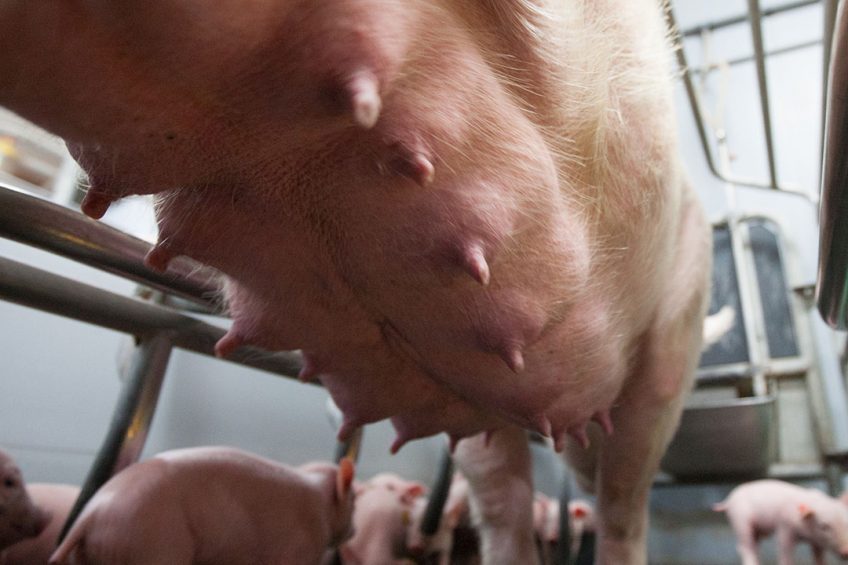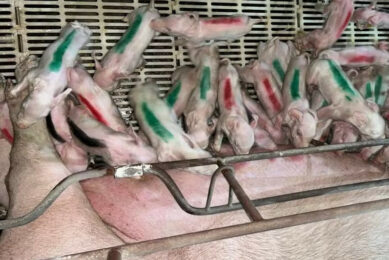All about sows, udders and MMA (part 1)

The letters ‘MMA’ sound familiar to many pork producers having sows on-farm. What causes the 3 underlying problems and what can be done to make life better for sows? Pig management expert John Gadd dives into these 3 letters and brings back a wealth of useful tips and tricks.
I have been asked to say a few words on this nuisance from my past experience of it around the world. I shall break in down into 2 articles.
Is the incidence of MMA rising or falling?
A 4% incidence is to be expected, and up to 10% on some units I have visited. So the answer seems to be both.
As you already know, the combined disorder known as MMA is comprised of mastitis, metritis and agalactia. 3 separate but often associated conditions. The first 2 M’s are most common in poorly managed herds, due mostly to poor hygiene. I am happy to say these farms with substandard conditions are few and far between, so MMA from infectious causes seems to me to be lessening somewhat across the world, but I could be wrong.
On the other hand stress from prolonged farrowing these days must be a ‘modern’ factor, as sows, as we all know, are producing larger litters, so parturition time is extended by natural means. The strain of expelling more pigs in the delivery pipeline (the old term for it was ‘hysteria’ which I always felt was misleading and ‘farrowing stress’ is perhaps a better one) has been the inevitable cause of all three, so the incidence is rising. I experience it noticeably so on the better farms.
What to do about MMA?
If the first M, ‘mastitis’, is infection of the udder and the second, ‘metritis’, is infection of the womb, then, as the textbooks have been telling us for decades, keep things much cleaner before, during and after the farrowing process is essential. Simplistic advice, but for me after a check on what was being done when I visited a farm – plus a few swab tests of surfaces to alarm staff on what ‘really clean’ means, most producers ruefully admitted at the next visit that better cleaning was the correct advice, as the incidences had noticeably lessened.
Underfeeding and poor quality sow diets providing insufficient lactose are also a cause. Conversely, on the more advanced farms, overfeeding before and too soon after farrowing can lead to impaction in the sow’s stomach. Stomach acid is unable to penetrate the dense mass of, the usually rich, food they tend to use.
Coarse bran has been advised but I have always found dried sugar beet pulp to be far better, at 5% added to the diet. Oxytocin injections I have seen work, but it is easy to overdose, so under veterinary supervision, please. This is said to help in speeding up farrowing if needed – again on a pig vet’s advice. Table 1 sums up the position for MMA.
Agalactia: Avoiding stress is key
Quite a tricky problem to solve, I’ve found. Years ago I sat at the feet of an Austalian pig vet. Belinda Walker, who had a reputation for largely erasing it from Queensland herds.
She wrote: “Prevention of agalactia is largely a matter of good management so that stress is avoided. Overfeeding, particularly in the final few weeks before farrowing, should be avoided and bran should replace part of the diet in the last week to ensure that the sow is not constipated. The sow should enter the farrowing crate clean and in plenty of time to get used to her new surroundings.”
Gilts especially, say I.
Read also: Preventing postpartum dysgalactia syndrome
What to do with agitated sows?
She continued, “After farrowing, gilts or sows which seem agitated should be tranquillised. Those that were overdue , larger litters or prolonged farrowing should be watched closely. Anti-inflammatory drugs given if swelling is apparent. Take sows’ temperatures on the afternoon after farrowing when piglet’s teeth and tails are done. The sow’s udders should be palpated (how is explained in part 2, JG) and anti-inflammatory drugs given if any swelling is apparent. Sows’ temperatures should be taken on the afternoon after farrowing and/ or when piglets teeth and tails are done.
“Antibiotics are given if temperature exceeds 39.5˚C. Most sows’ temperatures may be elevated immediately after farrowing but should subside within 24 hours. If in doubt repeat the process 12 hours later, and treat if still elevated. Sows that remain off their feed for any length of time, say 2 to 3 feeds, should also be checked, as should their water supply.”
Treating with antibiotics for a minimum of 3 days
Still Belinda Walker said: “Any sows with mastitis, an excessive vaginal discharge, or blood/ pus in the urine should be treated with antibiotics for a minimum of 3 days while the sow is not milking. Her litter should be offered a milk substitute – there are several specialist piglet-only powders available – but they must be provided in super clean containers/ dispensers.”
I often tell staff myself that the containers must be ‘washed up’ as often as we do for the our own meals – which rather shakes them!











